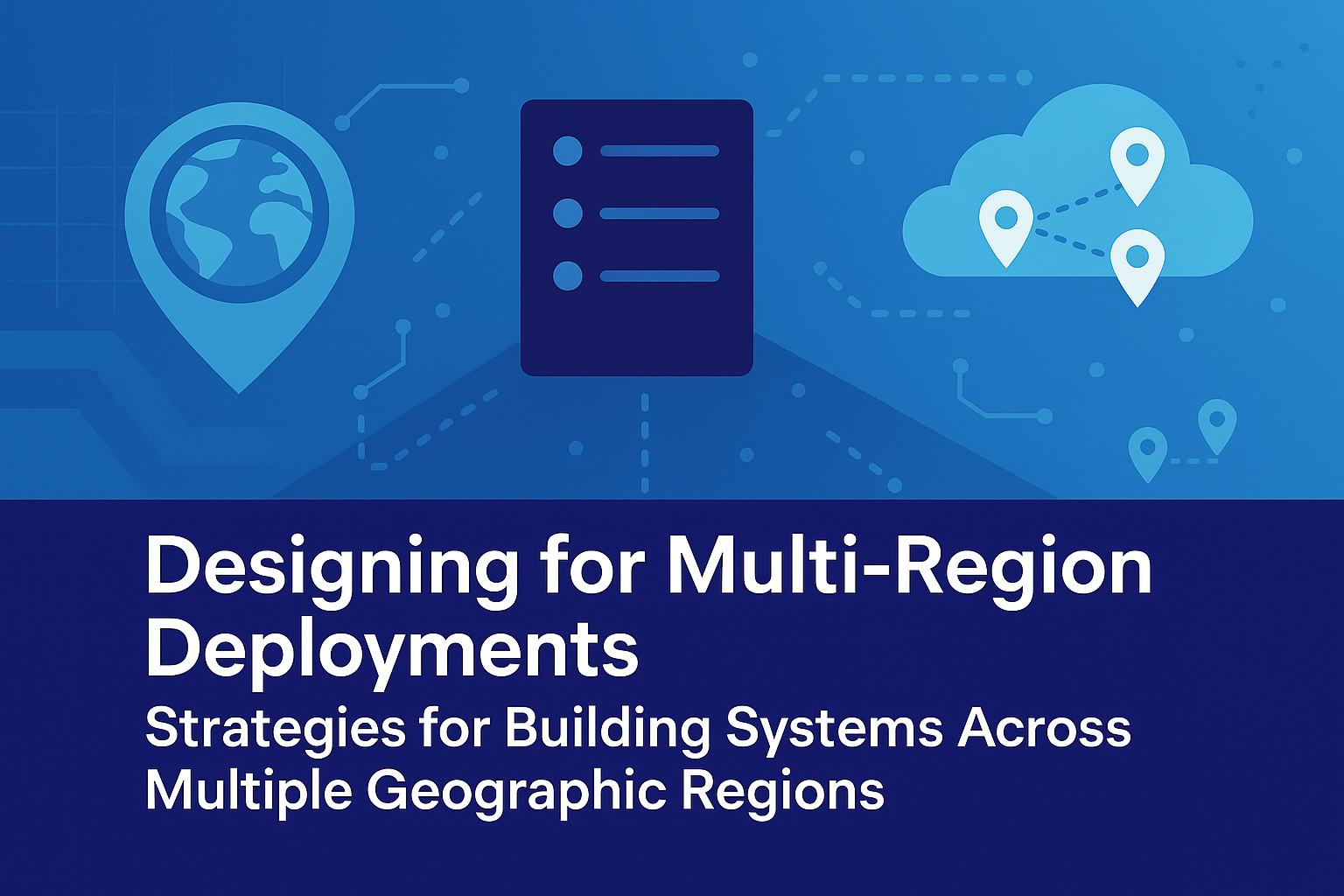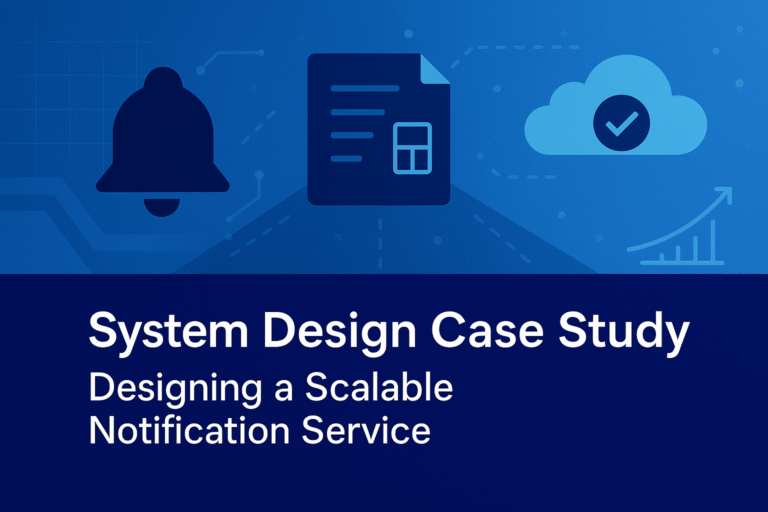Introduction
Multi-region deployments involve distributing system components—such as databases, caches, and services—across geographically diverse data centers to enhance availability, reduce latency, and comply with regulatory requirements. This approach is essential for global applications that must deliver consistent performance to users worldwide while mitigating risks from regional failures, such as natural disasters or power outages. By deploying in multiple regions (e.g., AWS us-east-1, eu-west-1, ap-southeast-1), systems can achieve lower latency for end-users (e.g., < 50ms for nearby regions vs. 100–200ms cross-continent) and higher resilience (e.g., 99.999% uptime). However, multi-region designs introduce complexities in data replication, consistency, and cost management. This detailed analysis explores the strategies for designing multi-region systems, their mechanisms, applications, advantages, limitations, and real-world examples. It integrates prior concepts such as the CAP Theorem, consistency models, consistent hashing, idempotency, unique IDs, heartbeats, failure handling, single points of failure (SPOFs), checksums, GeoHashing, rate limiting, Change Data Capture (CDC), load balancing, and leader election to provide a holistic view for system design professionals.
Key Challenges in Multi-Region Deployments
Multi-region systems face several inherent challenges that must be addressed to ensure effective operation:
- Latency Variations: Inter-region network delays can range from 50ms (intra-continent) to 200ms (inter-continent), impacting user experience and system performance.
- Data Consistency: Maintaining consistency across regions (e.g., strong vs. eventual) while handling replication lag (10–100ms) aligns with the CAP Theorem, often requiring trade-offs between consistency and availability.
- Regulatory Compliance: Data sovereignty laws (e.g., GDPR) mandate storing data in specific regions, complicating replication and access.
- Cost Overhead: Multi-region replication increases storage and network costs (e.g., $0.05/GB/month for cross-region transfer).
- Fault Tolerance: Regional failures require seamless failover (< 5s) without data loss, integrating heartbeats and leader election.
- Scalability: Balancing load across regions while minimizing data movement uses consistent hashing and load balancing.
- Security and Integrity: Ensuring data integrity during cross-region transfers involves checksums (e.g., SHA-256) and encryption (e.g., TLS 1.3).
These challenges necessitate strategies that optimize for global performance while managing complexity and cost.
Strategies for Multi-Region Deployments
1. Active-Active Replication
This strategy involves all regions actively serving read and write requests, with data replicated bidirectionally to ensure high availability and low latency.
- Mechanism:
- Data is written to the local region and asynchronously replicated to others (e.g., using CDC streams like DynamoDB Streams or Kafka).
- Conflict resolution employs last-write-wins, vector clocks, or CRDTs (Conflict-free Replicated Data Types) to handle concurrent writes.
- Read requests are served from the nearest region, reducing latency (e.g., < 50ms).
- Integrates with consistent hashing for data partitioning and load balancing (e.g., Least Connections) for routing.
- Mathematical Foundation:
- Replication Lag: Lag = network_delay + processing_time (10–100 ms)
- Availability: 1 − (1 − region_availability)R (e.g., 99.999% for 3 regions at 99.9%)
- Throughput: Σ regional_throughputs (e.g., 1M req/s × 3 = 3M req/s)
- Applications: Global e-commerce (e.g., user sessions), social media feeds (e.g., Twitter timelines), and real-time analytics.
Advantages
- Low Latency: Serves from nearest region (< 50ms vs. 200ms cross-region).
- High Availability: 99.999% uptime, as failures in one region do not affect others.
- Scalability: Independent regional scaling (e.g., add nodes in high-traffic regions).
Limitations
- Eventual Consistency: Replication lag (10–100ms) risks stale data.
- Conflict Complexity: Requires resolution logic (e.g., CRDTs add 10–20% overhead).
- Cost Increase: Cross-region replication adds bandwidth costs ($0.05/GB/month).
Real-World Example
- Twitter Global Feeds:
- Context: 500M users worldwide, needing low-latency feed access.
- Implementation: Active-active replication across 3 regions (e.g., us-east-1, eu-west-1), CDC via Kafka for feed updates, consistent hashing for partitioning, rate limiting with Token Bucket.
- Performance: < 50ms latency, 99.999% uptime, 2M req/s.
- Trade-Off: Eventual consistency (10–100ms lag) for availability.
Implementation Considerations
- Replication: Use async with CRDTs for conflict resolution.
- Monitoring: Track lag (< 100ms) with Prometheus.
- Security: Encrypt replication traffic with TLS 1.3, use checksums (SHA-256).
2. Active-Passive Replication (Failover)
This strategy designates one region as active (handling all writes/reads) and others as passive (standby replicas), with failover to passive regions during outages.
- Mechanism:
- Writes are directed to the active region, synchronously or asynchronously replicated to passives (e.g., DynamoDB Global Tables).
- On failure (detected by heartbeats, < 3s), traffic is rerouted to a passive region via DNS failover or load balancing.
- Integrates with leader election (e.g., Raft in etcd) for active region selection.
- Uses CDC for data synchronization and consistent hashing for post-failover distribution.
- Mathematical Foundation:
- Failover Time: MTTD + MTTR (e.g., <3s detection + <5s rerouting = <8s)
- Availability: 1 − downtime_fraction (e.g., 99.99% with <5s failover)
- Latency: Local (<50 ms) in active region, increases during failover (100–200 ms)
- Applications: Disaster recovery for financial systems (e.g., PayPal), global databases with strong consistency.
Advantages
- Strong Consistency: Active region ensures consistent data (e.g., CP alignment).
- Simplified Management: Fewer conflicts than active-active.
- Cost Efficiency: Passive regions can use cheaper resources until activated.
Limitations
- Higher Latency: Users far from active region face 100–200ms delays.
- Failover Downtime: 5–10s during switch, impacting availability.
- Underutilization: Passive regions idle until failover, wasting resources.
Real-World Example
- PayPal Financial Services:
- Context: 1M transactions/day, needing strong consistency and DR.
- Implementation: Active region in us-east-1 with DynamoDB, passive in eu-west-1, synchronous replication, failover via Route 53 DNS (< 5s), leader election for coordination.
- Performance: < 10ms latency in active region, 99.999% uptime.
- Trade-Off: Higher cost for replication but strong consistency.
Implementation Considerations
- Failover: Use Route 53 or Global Accelerator for traffic rerouting.
- Monitoring: Track heartbeats (1s) and lag (< 100ms) with Prometheus.
- Security: Use checksums (SHA-256) for replicated data integrity.
3. Geo-Routing and Locality-Aware Design
This strategy routes requests to the nearest region based on user location, optimizing latency while replicating data for consistency.
- Mechanism:
- Use GeoHashing or IP-based routing (e.g., AWS Route 53 Geo-Location) to direct requests to the closest region.
- Replicate data asynchronously across regions (e.g., CDC via Kafka for eventual consistency).
- Handle writes by routing to a primary region or using multi-master replication.
- Integrate with load balancing (e.g., Least Connections) within regions.
- Mathematical Foundation:
- Latency Reduction:
, e.g., < 50ms for 5,000km.
- Availability: Regional independence reduces global downtime to < 0.01%.
- Latency Reduction:
- Applications: Global user bases (e.g., Netflix content delivery, Twitter feeds).
Advantages
- Ultra-Low Latency: < 50ms for local requests.
- High Availability: Regional failures affect only local users.
- User Experience: Faster responses improve satisfaction.
Limitations
- Replication Lag: 10–100ms for cross-region data (eventual consistency).
- Cost: Higher for global replication (e.g., $0.05/GB/month transfer).
- Complexity: Geo-routing and multi-region replication add 15–20% effort.
Real-World Example
- Netflix Streaming:
- Context: 1B requests/day, needing < 50ms global latency.
- Implementation: Geo-routing with Route 53, active-active replication via Kafka CDC, consistent hashing for load distribution, GeoHashing for content localization.
- Performance: < 50ms latency, 99.999% uptime, 1M req/s per region.
- Trade-Off: Eventual consistency for low latency.
Implementation Considerations
- Routing: Use GeoHashing for location-aware keys, Route 53 for DNS routing.
- Monitoring: Track regional latency (< 50ms) with Prometheus.
- Security: Use checksums (SHA-256) for replicated data.
4. Multi-Master Replication
This strategy allows writes in multiple regions, with bidirectional replication for high availability and low latency.
- Mechanism:
- All regions accept writes, replicated to others (e.g., DynamoDB Global Tables with last-write-wins resolution).
- Conflict resolution using timestamps, vector clocks, or CRDTs.
- Read-local, write-anywhere model, integrated with GeoHashing for location-based routing.
- Mathematical Foundation:
- Conflict Rate:
, e.g., < 0.1% for 100ms lag.
- Conflict Rate:
- Applications: Global e-commerce with local writes (e.g., Amazon international orders).
Advantages
- Global Low Latency: < 50ms writes/reads from any region.
- High Availability: No single primary SPOF.
- Scalability: Distributed writes increase throughput (e.g., 1M/s).
Limitations
- Conflict Complexity: Requires advanced resolution (e.g., CRDTs add 10–20% overhead).
- Consistency: Eventual consistency risks 10–100ms staleness.
- Cost: High replication traffic ($0.05/GB/month).
Real-World Example
- Uber Global Operations:
- Context: 1M rides/day across regions, needing local writes.
- Implementation: Multi-master Cassandra with bidirectional replication, GeoHashing for routing, Kafka CDC for analytics.
- Performance: < 50ms latency, 99.999% uptime, 1M req/s.
- Trade-Off: Eventual consistency with last-write-wins resolution.
Implementation Considerations
- Conflict Resolution: Use CRDTs or timestamps for automated handling.
- Monitoring: Track replication lag (< 100ms) with Prometheus.
- Security: Use checksums (SHA-256) for data integrity.
5. Hybrid Replication (Active-Active with Active-Passive Fallback)
This strategy combines active-active for normal operation with active-passive failover for resilience.
- Mechanism:
- Active-active for low-latency multi-region operations, switching to active-passive on failure detection (e.g., via heartbeats).
- Uses CDC for replication and leader election (e.g., Raft) for primary selection.
- Mathematical Foundation:
- Failover Time: < 5s with heartbeats (1s interval, 3s timeout).
- Applications: Mission-critical global systems (e.g., financial services with DR).
Advantages
- Balanced Latency and Resilience: < 50ms normal, < 5s failover.
- Cost Efficiency: Passive regions use lower resources until activated.
Limitations
- Complexity: Hybrid logic adds 15–20% effort.
- Consistency: Risks staleness during active-active (10–100ms).
Real-World Example
- Google Cloud Services:
- Context: Global users needing low latency and DR.
- Implementation: Spanner with active-active replication (Paxos), active-passive fallback, heartbeats for detection.
- Performance: < 50ms latency, 99.999% uptime, 1M req/s.
- Trade-Off: Complexity for resilience.
Implementation Considerations
- Failover: Use Route 53 for traffic switch, heartbeats (1s) for detection.
- Monitoring: Track failover time (< 5s) with Prometheus.
- Security: Encrypt data with TLS 1.3.
Integration with Prior Concepts
- CAP Theorem: Multi-region strategies prioritize AP for availability (e.g., active-active) or CP for consistency (e.g., active-passive).
- Consistency Models:
- Strong Consistency: Active-passive with synchronous replication (e.g., PayPal).
- Eventual Consistency: Active-active with async replication (e.g., Twitter).
- Consistent Hashing: Distributes data across regions (e.g., DynamoDB).
- Idempotency: Ensures safe multi-region writes (e.g., SETNX in Redis).
- Unique IDs: Snowflake for region-aware IDs (e.g., datacenter ID in Snowflake).
- Heartbeats: Detect regional failures (e.g., 1s interval).
- Failure Handling: Failover with retries and circuit breakers.
- SPOFs: Multi-region replication eliminates regional SPOFs.
- Checksums: SHA-256 for replicated data integrity.
- GeoHashing: Routes requests with GeoHash-based locality.
- Load Balancing: Least Connections for intra-region balancing, Geo-Routing for inter-region.
- Rate Limiting: Token Bucket for regional traffic control.
- CDC: Propagates changes across regions (e.g., DynamoDB Streams).
- Caching Strategies: Cache-Aside with regional Redis for low latency.
- Eviction Policies: LRU for regional caches.
- Bloom Filters: Reduce cross-region queries.
Real-World Examples
- Amazon Global E-Commerce:
- Context: 10M orders/day across regions, needing low latency and compliance.
- Implementation: Active-active replication with DynamoDB Global Tables, Geo-Routing via Route 53, CDC via Streams to Kafka, consistent hashing for load distribution.
- Performance: < 50ms latency, 99.999% uptime, 1M req/s per region.
- Trade-Off: Eventual consistency with last-write-wins.
- Netflix Content Delivery:
- Context: 1B streaming requests/day, needing regional optimization.
- Implementation: Active-active with Open Connect CDN, Geo-Routing, multi-master replication, GeoHashing for localization, heartbeats for failure detection.
- Performance: < 50ms latency, 99.999% uptime, 10M req/s globally.
- Trade-Off: Eventual consistency for low latency.
- Uber Ride Services:
- Context: 1M rides/day globally, needing local processing.
- Implementation: Multi-master Cassandra with bidirectional replication, Geo-Routing with GeoHashing, CDC for analytics, leader election for coordination.
- Performance: < 50ms latency, 99.999% uptime, 1M req/s.
- Trade-Off: Conflict resolution complexity for scalability.
- PayPal Financial Transactions:
- Context: 1M transactions/day, needing strong consistency and DR.
- Implementation: Active-passive with DynamoDB Global Tables, failover via Route 53 (< 5s), synchronous replication, heartbeats (1s interval).
- Performance: < 10ms latency in active region, 99.999% uptime.
- Trade-Off: Higher latency for strong consistency.
Trade-Offs and Strategic Considerations
- Latency vs. Availability:
- Trade-Off: Active-active reduces latency (< 50ms) but risks consistency (10–100ms lag); active-passive ensures consistency but increases latency for distant users (100–200ms).
- Decision: Use active-active for global apps (Netflix), active-passive for compliance-heavy systems (PayPal).
- Interview Strategy: Justify active-active for Uber, emphasizing Geo-Routing.
- Consistency vs. Scalability:
- Trade-Off: Multi-master scales writes (1M/s) but requires conflict resolution (e.g., CRDTs add 10–20% overhead); active-passive simplifies consistency but limits scale to the active region.
- Decision: Use multi-master for high-write systems (Twitter), active-passive for strong consistency (PayPal).
- Interview Strategy: Propose multi-master for Amazon, active-passive for financial data.
- Cost vs. Resilience:
- Trade-Off: Multi-region replication increases costs ($0.05/GB/month for transfer) but enhances resilience (99.999% uptime); single-region is cheaper but risks outages.
- Decision: Use multi-region for mission-critical apps, single-region for development.
- Interview Strategy: Highlight cost-benefit for Netflix’s multi-region.
- Complexity vs. Performance:
- Trade-Off: Geo-Routing and multi-master add complexity (15–20% effort) but reduce latency (< 50ms); simpler designs increase latency (100–200ms).
- Decision: Use Geo-Routing for user-facing systems, simpler replication for internal.
- Interview Strategy: Justify GeoHashing and Geo-Routing for Uber.
- Security vs. Latency:
- Trade-Off: Cross-region encryption (TLS 1.3) adds < 1ms latency but ensures integrity; unencrypted replication risks tampering.
- Decision: Use encryption for sensitive data, skip for internal non-sensitive traffic.
- Interview Strategy: Propose TLS 1.3 with resumption for PayPal.
Advanced Implementation Considerations
- Deployment:
- Use AWS Global Accelerator or Route 53 for Geo-Routing, DynamoDB Global Tables for replication.
- Deploy across 3 regions with 10 nodes each (16GB RAM, cache.r6g.large).
- Configuration:
- Replication: Async for active-active, sync for active-passive.
- Consistency: Use CRDTs or last-write-wins for multi-master conflicts.
- Routing: GeoHashing for location-based keys, consistent hashing for load distribution.
- Performance Optimization:
- Use Redis for regional caching (< 0.5ms), pipelining for 90% RTT reduction.
- Size Bloom Filters for 1% false positive rate (9.6M bits for 1M keys).
- Tune replication factor to 3 for 99.999% availability.
- Monitoring:
- Track latency (< 50ms), uptime (99.999%), and lag (< 100ms) with Prometheus/Grafana.
- Use CloudWatch for Route 53, monitor failover time (< 5s).
- Security:
- Encrypt data with AES-256, use TLS 1.3 with session resumption.
- Implement RBAC, use checksums (SHA-256) for replicated data.
- Use VPC peering for secure inter-region communication.
- Testing:
- Stress-test with JMeter for 1M req/s.
- Validate failover (< 5s) with Chaos Monkey.
- Test conflict resolution with simulated concurrent writes.
Discussing in System Design Interviews
- Clarify Requirements:
- Ask: “What’s the user distribution (global/regional)? Latency target (< 50ms)? Availability (99.999%)? Regulatory needs (GDPR)?”
- Example: Confirm global users for Netflix with < 50ms latency.
- Propose Strategies:
- Active-Active: “Use for Twitter feeds with eventual consistency.”
- Active-Passive: “Use for PayPal transactions with strong consistency.”
- Geo-Routing: “Use for Uber with GeoHashing.”
- Multi-Master: “Use for Amazon orders with CRDTs.”
- Hybrid: “Use for Google with active-active and passive fallback.”
- Example: “For Netflix, implement active-active with Geo-Routing and CDC.”
- Address Trade-Offs:
- Explain: “Active-active reduces latency but risks consistency; active-passive ensures consistency but increases cost.”
- Example: “Use active-active for Netflix, active-passive for PayPal.”
- Optimize and Monitor:
- Propose: “Use GeoHashing for routing, Kafka CDC for replication, monitor lag with Prometheus.”
- Example: “Track regional latency and uptime for Uber.”
- Handle Edge Cases:
- Discuss: “Mitigate lag with CRDTs, handle failures with heartbeats and failover.”
- Example: “For Amazon, use Route 53 failover with < 5s recovery.”
- Iterate Based on Feedback:
- Adapt: “If latency is critical, use Geo-Routing; if consistency is key, use active-passive.”
- Example: “For Twitter, switch to multi-master for write-heavy feeds.”
Conclusion
Designing for multi-region deployments is crucial for achieving global scalability, low latency, and high resilience in distributed systems. Strategies like active-active replication, active-passive failover, geo-routing, multi-master replication, and hybrid approaches address challenges such as latency variations, consistency, and regulatory compliance, while integrating with concepts like the CAP Theorem, consistent hashing, and CDC. Real-world examples from Amazon, Netflix, Uber, and PayPal illustrate how these strategies deliver < 50ms latency, 99.999% uptime, and high throughput (1M req/s per region). Trade-offs like latency vs. availability, consistency vs. scalability, and cost vs. resilience guide selection, enabling architects to create robust systems that balance performance, reliability, and efficiency for global applications.




